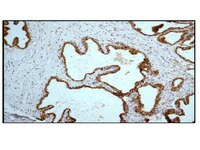TANK-binding kinase 1 (TBK1) controls cell survival through PAI-2/serpinB2 and transglutaminase 2.
Delhase, M; Kim, SY; Lee, H; Naiki-Ito, A; Chen, Y; Ahn, ER; Murata, K; Kim, SJ; Lautsch, N; Kobayashi, KS; Shirai, T; Karin, M; Nakanishi, M
Proceedings of the National Academy of Sciences of the United States of America
109
E177-86
2011
Afficher le résumé
The decision between survival and death in cells exposed to TNF relies on a highly regulated equilibrium between proapoptotic and antiapoptotic factors. The TNF-activated antiapoptotic response depends on several transcription factors, including NF-κB and its RelA/p65 subunit, that are activated through phosphorylation-mediated degradation of IκB inhibitors, a process controlled by the IκB kinase complex. Genetic studies in mice have identified the IκB kinase-related kinase TANK-binding kinase 1 (TBK1; also called NAK or T2K) as an additional regulatory molecule that promotes survival downstream of TNF, but the mechanism through which TBK1 exerts its survival function has remained elusive. Here we show that TBK1 triggers an antiapoptotic response by controlling a specific RelA/p65 phosphorylation event. TBK1-induced RelA phosphorylation results in inducible expression of plasminogen activator inhibitor-2 (PAI-2), a member of the serpin family with known antiapoptotic activity. PAI-2 limits caspase-3 activation through stabilization of transglutaminase 2 (TG2), which cross-links and inactivates procaspase-3. Importantly, Tg2(-/-) mice were found to be more susceptible to apoptotic cell death in two models of TNF-dependent acute liver injury. Our results establish PAI-2 and TG2 as downstream mediators in the antiapoptotic response triggered upon TBK1 activation. | 22203995
 |
Transcriptional regulation of mouse TREM-1 gene in RAW264.7 macrophage-like cells.
Hiroshi Hosoda,Hiroshi Tamura,Satoshi Kida,Isao Nagaoka
Life sciences
89
2010
Afficher le résumé
Triggering receptor expressed on myeloid cells (TREM)-1 is expressed in macrophages, and functions as an amplifying molecule in inflammatory responses. TREM-1 is constitutively expressed in macrophage, and upregulated by bacterial components, such as lipopolysaccharide (LPS). In this present study, we investigated the regulatory mechanism for the basal and LPS-induced transcription of mouse TREM-1 gene in mononuclear cells using RAW264.7 macrophage-like cells. | 21683719
 |
Dynamic histone H3 acetylation and methylation at human cytomegalovirus promoters during replication in fibroblasts.
Cuevas-Bennett, C; Shenk, T
Journal of virology
82
9525-36
2008
Afficher le résumé
Human cytomegalovirus DNA is packaged in virions without histones but associates with histones upon reaching the nucleus of an infected cell. Since transcription is modulated by the interplay of histone modifications, we used chromatin immunoprecipitation to detect acetylation and methylation of histone H3 at viral promoters at different times during the viral replication cycle. Histone H3 at immediate-early promoters is acetylated at the start of infection, while it is initially methylated at early and late promoters. Acetylation at immediate-early promoters is dynamic, with a high level of activating modifications at 3 and 6 h postinfection (hpi), followed by a marked reduction at 12 hpi. All viral promoters, as well as nonpromoter regions, are modified with activating acetylations at 24 to 72 hpi. The transient reduction in histone H3 acetylation at the major immediate-early promoter depends on the cis-repressive sequence to which the UL122-coded IE2 protein binds. A mutant virus lacking this element exhibited decreased IE2 binding at the major immediate-early promoter and failed to show reduced acetylation of histone H3 residing at this promoter at 12 hpi. Our results demonstrate that cytomegalovirus chromatin undergoes dynamic, promoter-specific histone modifications early in the infectious cycle, after which the entire chromosome becomes highly acetylated. Article en texte intégral | 18653451
 |











